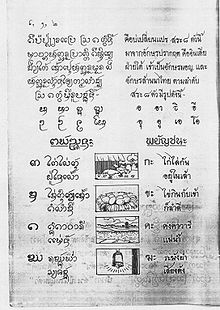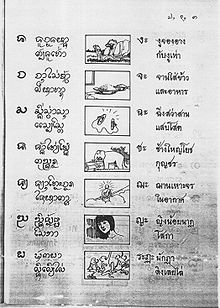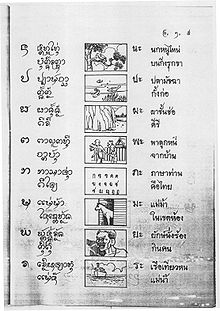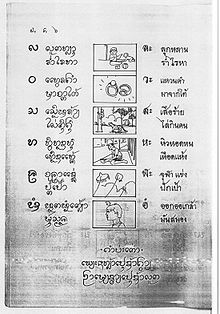- Northern Thai language
-
Northern Thai  Kam Mueang
Kam Mueang
ᨣᩴᩤᨾᩮᩥᩬᨦPronunciation [kam˧ mɯːəŋ˧] Spoken in Thailand, Burma, Laos, Cambodia Region Northern Thailand Native speakers 6 million (date missing) Language family Writing system Tai Tham script, Thai script Language codes ISO 639-3 nod This page contains Indic text. Without rendering support you may see irregular vowel positioning and a lack of conjuncts. More... This page contains IPA phonetic symbols in Unicode. Without proper rendering support, you may see question marks, boxes, or other symbols instead of Unicode characters. Northern Thai, Lanna, or Kham Mueang (Northern Thai: ᨣᩴᩤᨾᩮᩥᩬᨦ [kam˧ mɯːəŋ˧], Thai: คำเมือง [kʰam˧ mɯːəŋ˧]) is the language of the Thai Yuan people of Lannathai, Thailand. It is a Tai language, closely related to Thai and Lao. Northern Thai has approximately six million speakers, most of whom live in Thailand, with a few thousand in northwestern Laos.
Speakers of this language generally consider the name Yuan to be pejorative. They generally call themselves kon mueang (กนเมือง, [kon˧ mɯːəŋ˧]), Lannathai, or Northern Thai. The language is generally known by one of these terms, or as Phayap. The term Yuan is still used for the distinctive Tai Tham script that Northern Thai uses, which is closely related to the old Tai Lue Script and the Lao religious alphabets. It also resembles the Burmese and Mon alphabets. (All these alphabets derive from the Old Mon alphabet.) The use of the tua mueang, as the traditional alphabet is known, is now largely limited to Buddhist temples, where many old sermon manuscripts are still in active use. There is no active production of literature in the traditional alphabet.
Most linguists consider Northern Thai to be more closely related to Thai and the other Chiang Saeng languages than to Lao and the Lao–Phutai languages, but the distinction is never easy to make, as the languages form a continuum with few sharp dividing lines.
Contents
Grammar
Pronouns
Pronouns may be omitted once they have already been established in the first sentence, unless the pronoun in the following sentences is different from the first sentence. The pronoun "you" may also be omitted if the speaker is speaking directly to a second person. Moreover, names may replace pronouns, and they can even replace the first person singular pronoun.
Tai Tham script Thai script Transliteration IPA Meaning ᨢ᩶ᩣ ข้า kha̋a kʰaː˥˧ I/me (formal; used by male) ᨢ᩶ᩣᨧᩮᩢ᩶ᩣ ข้าเจ้า kha̋aja̋o kʰaː˥˧tɕaw˥˧ I/me (formal; used by female) ᩁᩣ ฮา haa haː˧ I/me (informal) ᩁᩮᩢᩣ เฮา hao haw˧ we/us (general) ᨲᩫ᩠ᩅ ตั๋ว tǔa tua˩˥ you (general, singular) ᨤᩥ᩠ᨦ ฅิง khing kʰiŋ˧ you (informal, singular) ᨧᩮᩢ᩶ᩣ เจ้า ja̋o tɕaw˥˧ you (formal, singular) ᨸᩮᩥ᩠᩶ᨶ เปิ้น pôen pɤn˥˩ I/me (formal, general), he/she (general) ᨾᩢ᩠ᨶ มัน man man˧ it (very rude if used on a person) Phonology
Tones
There are six phonemic tones in the Chiangmai dialect of Northern Thai: low-rising, mid-low, high-falling, mid-high, falling, and high rising-falling.[1]
Tone Example Phonemic Phonetic Example meaning in English low-rising ขา /xǎː/ [xaː˩˦] leg mid-low ข่า /xàː/ [xaː˨˨] galangal high-falling ฃ้า /xa̋ː/ [xaː˥˧] to kill mid-high ฅา /xaː/ [xaː˦˦] thatch grass falling ไร่ /hâjː/ [hajː˦˩] dry field high rising-falling ฟ้า /fáː/ [faː˦˥˦] sky Consonants
Northern Thai phonology is relatively closer to Lao phonology because of the [ ɲ ] sound.
Bilabial Labio-
dentalAlveolar Alveolo-
palatalPalatal Velar Glottal Nasal [ m ] [ n ] [ ɲ ] [ ŋ ] Plosive [ p ] [ pʰ ] [ b ] [ t ] [ tʰ ] [ d ] [ k ] [ kʰ ] [ ʔ ]* Fricative [ f ] [ s ] [ x ] [ h ] Affricate [ tɕ] Approximant [ w ] [ j ] Lateral
approximant[ l ] - * The glottal plosive is implied after a short vowel without final, or silent before a vowel.
Vocabulary
Northern Thai shares much vocabulary with Standard Thai, especially scientific terms, which draw many prefixes and suffixes from Sanskrit and Pali, and it also has its own distinctive words. Just like Thai and Lao, Lanna has borrowed many Sanskrit and Pali words.
Below, Thai words are shown on the left and Northern Thai words are shown on the right.
Different sounds
Standard Thai does not have palatal nasal sound:
- ยาก→ ยาก(/jâːk/ → /ɲâːk/, difficult)
- ยุง→ ยุง(/juŋ/ → /ɲuŋ/, mosquito)
- ยาว→ ยาว(/jaːw/> /ɲaːw/, long)
Standard Thai does not have a high-falling tone.
- บ้าน→ บ้าน(/bâːn/ → /ba̋ːn/, home)
- ห้า→ ห้า(/hâː/ → /ha̋ː/, five)
- เจ้า→ เจ้า(/tɕâw/ → /tɕa̋w/, you, lord)
Different words
Many words differ from Standard Thai greatly:
- ยี่สิบ → ซาว (/jîː sìp/ → /saːw/, twenty)
- พูด → อู้ (/pʰûːt/ → /űː/, to speak)
- พี่ชาย → อ้าย (/pʰîː tɕʰaːj/> /ʔa̋ːj/, older brother)
Similar words
Some words differ in tone only:
- หนึ่ง → นึ่ง (/nɯ̂ŋ/, one)
- หก → ฮก (/hók/, six)
- เจ็ด → เจ๋ด (/tɕět/, seven)
- สิบ → ซิบ (/síp/, ten)
- เป็น → เป๋น (/pěn/, to be)
- กิน → กิ๋น (/kǐn/, to eat)
Some words differ in a single sound and associated tone. In many words, the initial ร (/r/) is spoken as ฮ (/h/):
- ร้อน → ฮ้อน (/rɔ́n/ → /hɔ́n/, hot)
- รัก → ฮัก (/rák/ → /hák/, to love)
- รู้ → ฮู้ (/rúː/ → /húː/, to know)
Aspirated consonants in the low-class consonant group(อักษรต่ำ /ʔàk sɔ̌n tàm/) become unaspirated:
- เชียงราย → เจียงฮาย (/tɕʰiaŋ raːj/ → /tɕiaŋ haːj/, Chiang Rai city and province)
- คิด → กึ๊ด (/kʰít/ → /kít/, to think)
- ช้อน → จ๊อน (/tɕʰɔ́n/ → /tɕɔ́n/, spoon)
- ใช้ → ใจ๊ (/tɕʰáj/ → /tɕáj/, to use)
- พ่อ → ป้อ (/pʰɔ̂/ → /pɔ̂/, father)
- ทาง → ตาง (/tʰaːŋ/ → /taːŋ/, way)
Though many aspirated consonants often become unaspirated, when a unaspirated consonant is followed by ร (/r/) the unaspirated consonant becomes aspirated:
- โกรธ → โขด (/kròːt/ → /kʰòːt/, (be) angry)
- ประเทศ> ผะเตด (/praʔtʰêːt/ → /pʰaʔtêːt/, country)
- กราบ> ขาบ (/kràːp/ → /kʰàːp/, to prostrate oneself)
Other differences:
- ให้ → หื้อ (/hâj/ → /hɯ̋/, to give, let)
References
- ^ Gedney, William J., and Thomas J. Hudak. William J. Gedney's Tai Dialect Studies: Glossaries, Texts, and Translations. Ann Arbor, MI: Center for South and Southeast Asian Studies, The University of Michigan, 1997. Print.
- Khamjan, Mala (มาลา คำจันทร์). Kham Mueang Dictionary (พจนานุกรมคำเมือง). Chiang Mai: Bookworm, 2008. ISBN 978-974-84-1855-1.
Kra Kam–Sui Hlai (Proto-Hlai) • Hlai • JiamaoOng Be Tai Northern and Central Southwestern Northwestern Lao-Phutai Chiang Saen Thai • Northern Thai • Southern ThaiCategories:- Language articles with undated speaker data
- Languages of Laos
- Languages of Thailand
- Tai languages
Wikimedia Foundation. 2010.





